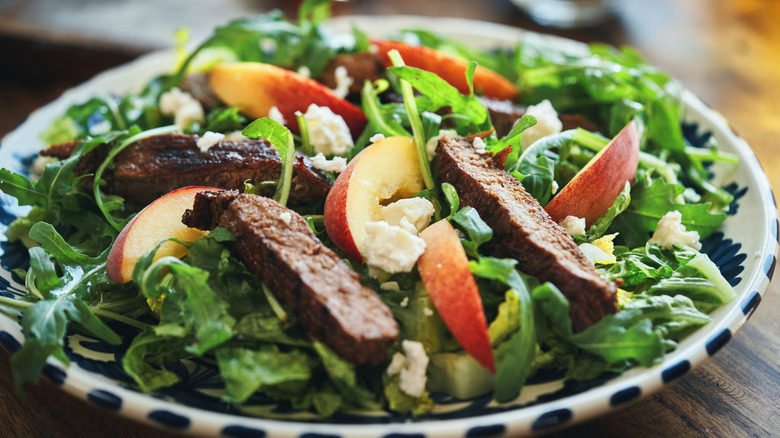Warm Salads Have A Long, Rich History
Warm salad might sound like an oxymoron, but it actually has a very long history. The concept of salad can be traced to the Roman tradition of salt-brining raw vegetables and topping them with oil. The word comes from the Latin root for "salt," referring to the way it used to be prepared. However, other versions of salad may have already existed around the world, and lettuce was served before this at royal feasts in Persia. In Egypt, lettuce was a fertility symbol thought to improve sexual stamina, and Greeks and Romans thought salad stimulated appetite and digestion. Famed father of physicians Hippocrates declared that salad aided digestion, and should be eaten before meals
Recipes from the Middle Ages referenced heating certain ingredients in the dish. While some recipes for warm salad focus on hot dressings or sauces, others center on cooking some of the ingredients to add complexity or improve the dish's overall flavor. A recipe from Robert May's 1660 book "The Accomplisht Cook" requires a huge amount of cooked and raw ingredients, including meat, oysters, and potatoes.
Perhaps the pinnacle of warm salad creation came in the form of Salamagundi or Salmagundy, a mix of seemingly every hot or cold ingredient that could be found in the kitchen, presented as a work of art. This dish, which originated in England in the 17th century framed salad as the main course, and over the years the name became modified to Solomon Gundy or Solomon Grundy.
Salad — especially warm salad — is more than just lettuce
German immigrants to the U.S. hundreds of years ago brought us a warm salad that's become a summer barbecue classic: German potato salad, which nixes the chilled mayo version in favor of warm potatoes tossed in a fatty, mustard-and-vinegar dressing. Other warm salads feature cooked cabbage or "warm slaw" dressed traditionally, according to an 1839 Kentucky recipe, with butter, salt, pepper, vinegar and "hard boiled yolks." Raw cabbage is a tough sell, and warm cabbage salad has become the perfect solution.
Generally, heartier greens can handle the heat better — bold and bitter lines of radicchio, endive, mustard greens, or kale. The heat mellows out the flavors of these greens — with the warmth of cooked ingredients or dressings providing a complement to the sharper bite. Take a warm spinach salad, for example, which brings warmth in the form of a hot dressing made with bacon drippings.
To understand the rich lineup of warm salads and their extensive history, it's worth expanding your idea of what qualifies as salad in the first place. Rice and other grains complement both warm and cold versions of the dish. Warm bean salads — like a Spanish mix of lima beans and celery united in a paprika and tomato dressing — might make you wonder just where the line falls between side dish and salad. Warm salad performs a delicate balancing act between cooked and uncooked ingredients, using heat to its advantage.

